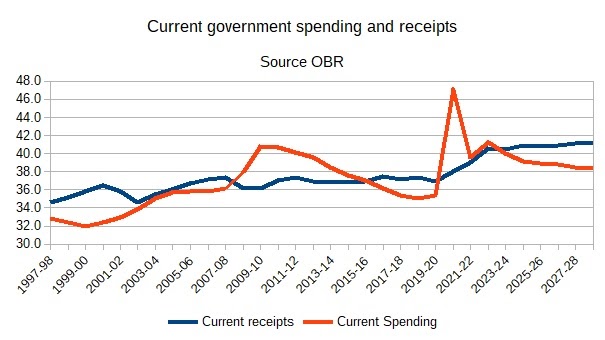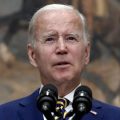This, my final post
on the forthcoming budget, is designed to provide a guide to how to
read what Reeves announces (or doesn’t announce) in a way that goes
rather deeper than the normal media commentary. My perspective, along
with a large part of the UK population, is how much does the budget
get us on a path designed to end public service austerity. (See
here for what I mean by that.) As I argued here, a budget that focuses on filling black holes rather than restoring public services will be a political failure. So I will start with
current public spending, go on to talk about what taxes might be
raised to match that spending, and finally talk about public
investment.
Public spending
As I outlined in
an earlier post, the share of public spending in GDP
needs to rise substantially to get back to an acceptable level of
provision. Below are the headline numbers for total current spending
(excluding gross investment) and taxes from the OBR’s
databank. We see the share of public spending in GDP
rise under the last Labour government and fall under the
Conservatives. The pandemic (with a little earlier help from the
Johnson government) provided a sharp increase, but the plans Reeves
inherited suggest a resumed decline.
A critical point
that I made in that earlier post, which is routinely ignored in most
analyses, is that this GDP share needs to rise over time because, in
the UK and most other countries, the share of health spending in GDP
has historically been on an upward trend for well known reasons. In
that post I estimated that, compared to levels today, current public
spending needed to rise by 3% of GDP to return to 2010 levels of
public service. However a better point of focus is the end point of
the OBR’s projections, and because of the decline in spending
Reeves has inherited the increase in spending has to be over 4% of
GDP by that date.
Although a spending
review for that period is yet to take place, Reeves will have to give
the OBR some indicative numbers, and these are what we need to focus
on. I don’t expect to see the share of current spending rise from
its 2023/4 level of 40% to 43% by the end of this decade, if only
because restoring public services to 2010 levels is a ten rather than
five year project. The key question is how far will Reeves go, which
in turn will depend in part on how much she can raise in tax, and in
part on the forecast the OBR gives her. As I
noted in my first post on the budget, economic growth
does not give you much in the way of additional resources for public
spending as a share of GDP, unless it is accompanied by public sector
productivity gains.
The OBR publishes
revised numbers for current public spending immediately after the
budget. There is always a risk that there will be an element of
Treasury/Cabinet game playing in the numbers Reeves gives the OBR,
However I would have thought anything less than a projected real term
increase in departmental spending, after allowing for much more for
the NHS, would be politically disastrous for the government. In
addition it will be very difficult (and wrong!) for Reeves not to at
least begin rolling back child poverty, and in particular abolishing
the two child limit and benefits cap. (See
this from the IFS on the impact of these policy
options on poverty.)
Tax increases
For tax increases
the numbers you will see in budget commentary will be in £ billion
(or £ million), so to give you an idea of scale raising public
spending by 1% of GDP in today’s prices will cost around £30
billion by the end of the decade, and after adding in inflation more
than £33 billion.
The tax rises in
Labour’s manifesto are small in comparison. VAT on private school
fees, a higher windfall tax on energy, closing non-dom loopholes and
ending the carried interest tax exemption raise about £4 billion.
Labour also hopes to raise £6 billion by spending more on tax
collection, but the OBR will need to make a judgement about how
realistic that is.
There are some tax
increases due to come in that were scheduled by the last government,
most notably the freezing rather than indexing of tax allowances. In
addition Covid business tax relief is due to end, fuel duty is due to
rise (ending a temporary cut and adding in uprating which the last
government routinely assumed but never did), and lowering the stamp
duty threshold. Reeves could reverse any of these, but that would
only add to the taxes she needs to find elsewhere.
So where are large
tax increases going to come from? Reeves has pledged that they should
not come from ‘working people’, but in practice that seems to
mean not from income tax, personal NIC contributions and VAT. Labour
has also pledged not to raise the rate of corporation tax. What is
left that would yield large amounts of money?
-
Employers
National Insurance Contributions
Raising the
contribution rate by 1% for employers would
raise about £5 billion net. (Beware larger
numbers quoted in the media that include contributions paid by the public
sector.) Another possibility is to extend national insurance payments
to employers’ pension contributions, which could
raise £12 billion (net of the public sector). Finally
she could remove the NIC higher earnings cap, which could raise over
£12 billion. Strangely (not really!) this possibility is hardly ever
discussed in the media. It is one of the steps needed to make
national insurance contributions more like income tax, with perhaps
the
eventual integration of the two taxes on income from
employment, but Reeves may feel it is precluded by Labour’s
pre-election promises.
-
Capital Gains
Tax (CGT)
At present, capital
gains are taxed at a much lower rate than incomes, which if nothing
else leads to a lot of tax avoidance. The details of what Reeves
could do quickly get quite complex, as are estimates of how much the
tax increase would raise. The key uncertainty is how much owners will
(initially at least) hold on to assets to avoid paying the higher
tax, hoping for a change of government. The OBR will have to take a
view on this. Equalisation is also not straightforward, because it
could involve just income tax, or it could involve all taxes on income from employment
including National Insurance. A
recent study suggested that equalisation with income
tax (with rates of 20%, 40% and 45%) plus a system of allowances and
other changes could raise £14 billion. Leaks
to the Guardian suggest Reeves is looking at increases
in the CGT rate from 20% (for most) to between 33% to 39%.
-
Investment
income
Reeves could raise
the tax rate on rental and dividend income. These are currently taxed
at similar rates to earned income, but they could be taxed at higher
rates. More radically, she could extend National Insurance
Contributions to investment income, which Advani estimates could
raise £11 billion.
-
Inheritance
tax
Raising this from
40% to 45% would only raise a billion according to the IFS ready
reckoner. (I would advocate a much bigger rise – sorry kids! – on
equity grounds.) There is probably more scope to raise money by
removing
various exemptions (e.g. business and agricultural
reliefs are worth 2 billion), and Reeves could be more radical still
and replace it with a gifts tax. I don’t expect it, but Reeves
could also introduce a wealth tax. Advani suggests a 1% annual tax
would raise £13 billion.
-
Extending the
freeze on tax thresholds
These are currently
frozen until April 2028. Reeves could extend these over the full OBR
forecast period, raising around £8 billion, but this really is an
income tax increase. Budget leaks suggest she intends to do this, and
perhaps she thinks this is politically safe as the Conservatives will
find it difficult to condemn her for continuing what they started.
There are a lot of
detailed changes that Reeves could make, which tend to be small in
revenue terms but can add up. For those who want to get into the
nitty gritty of all that and the above, there are plenty of good
resources around from, among others, the IFS (their ready
reckoner and Green
Budget), the Resolution
Foundation, Centax, the
Financial Times and Dan
Neidle.
The numbers above
indicate that there is clear scope for substantial increases in
taxes, even within the limits Labour has imposed on itself (with help
from the Conservatives). Whether they amount to enough to bring
public services back to 2010 levels is more doubtful. Most, but not all, of the
proposals mentioned above will mainly hit individuals who are well
off. Unfortunately the obvious redistributive tax change, raising taxes on very high earned income, is probably ruled out by Labour’s pre-election pledges.
Two final points.
The first is to look out for tax increases that could be extended
further in later years. In many cases gradualism makes economic
and/or political sense, and also see the point about Cabinet game
playing above. The second is to see if Reeves makes any initial moves
to introduce new taxes, such as road pricing for example.
Public
investment
There
has been plenty of discussion in the media of how she could amend the
‘falling debt to GDP’ fiscal rule to allow more borrowing for
investment, and almost no discussion of my own preferred option of
getting rid of the rule completely. This makes perfect sense as the
rule is designed to appease mediamacro rather than economists or the
markets!
Whatever
she decides to do, the key issue is how much extra public investment
she plans for by the end of the OBR’s forecast period. On present
plans net public investment is set to fall from 2.5% of GDP currently
to 1.7% by 2028/9. In my view this decline needs to be turned into a
substantial rise if we are going to catch up with all the investment
lost under the Conservatives.
As
the budget is on Wednesday next week, I will not do the usual post of
Tuesday, but instead delay it until Thursday or Friday to give my
own reactions to the budget.




